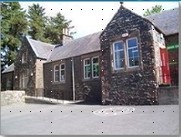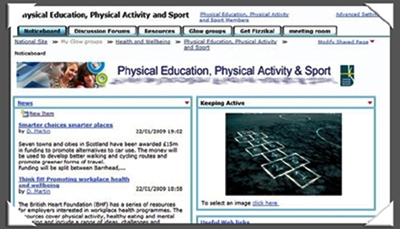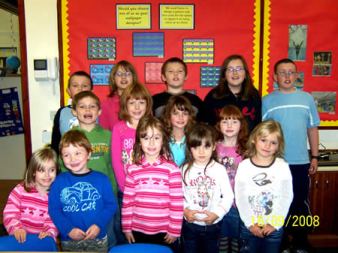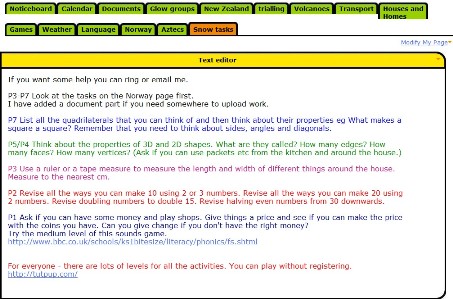

Glow Scotland blog
There are so many ways to view and use a Glow Group. The prime role may be for teaching and learning with a class, for collaboration among staff, for distribution of information. This week I met Lynne Bowie, Curriculum for Excellence Officer in Aberdeen City. Lynne is developing a Glow Group as a CPD resource. The Sharing of Good Practice Glow Group is designed to ensure all staff have access to resources, research and examples of effective practice, that will prepare them to teach within the Curriculum Framework.
When Lynne attended a Glow awareness-raising session run by the Aberdeen ICT Team, she realised what an opportunity Glow offers to deliver the materials she is developing to all Aberdeen teachers. In the present financial and environmental climate, Glow has many benefits. Using Glow reduces the need for lots of paper based resources. Using Glow to host the materials means everyone can access them, unlike conferences where only those lucky to attend are fully provided for (…and who can get out to go to conferences when there is so little class cover available?). Using Glow means that the project, which brings together good practice advice and examples, will be sustainable since the Glow Group can continue to develop as practices improve and more guidance comes out about delivering Scotland’s curriculum.
The Glow Group itself is really a mini-collection of sites. The parent group has the Curriculum Framework at its heart, in particular the Learning & Teaching portion. There are subgroups covering AifL, Active Learning, Co-operative Learning and Critical Skills – all tools that have been highlighted for Curriculum for Excellence. Each of these also has subgroups to ensure all the elements involved are given good coverage and allow staff interaction in discussion pages. Lynne is standardising the layout of each area so staff will become familiar with the template and know where to look for the research, key features and local exemplification that is on each noticeboard page.
The Glow Group is still in development but there is no doubt that Aberdeen practitioners will be well served by it when it launches at summer.
 A small primary school in the south west of Scotland is also discovering the benefits of Glow Meet. At Pinwherry Primary School in South Ayrshire, the composite class for the upper three levels has just 14 pupils. However, there is no worry here about such a small school being cut off from opportunities, thanks to Glow Meet. The class regularly holds web conferences with three other schools in the same authority and with another remote school on the Isle of Lewis.
A small primary school in the south west of Scotland is also discovering the benefits of Glow Meet. At Pinwherry Primary School in South Ayrshire, the composite class for the upper three levels has just 14 pupils. However, there is no worry here about such a small school being cut off from opportunities, thanks to Glow Meet. The class regularly holds web conferences with three other schools in the same authority and with another remote school on the Isle of Lewis.
Joint classes on Science are taught with Sacred Heart Primary School ten miles down the road and pupils collaborate on a Robert Burns project with Troon Primary School, 20 miles away. Linking with Dundonald Primary 40 miles away, the webcam can be on for a whole afternoon as pupils join up in reading groups, collaborative maths games and problem solving exercises between the two classes with the teachers swapping between them to cover different activities. Further links are being established with Marr College for a transition project in Maths.
Class activities using Glow can include any of the following: sharing news; completing homework; taking part in discussions; completing webquests; book detectives activities; links to interactive resources and writing collaborative stories. Their teacher Avril Taylor believes that her pupils are growing in confidence through their use of Glow and Glow Meet and getting opportunities which wouldn’t normally be available to them. We can attest to this as in recent training sessions delivered to 2 separate Scottish local authorities, the Pinwherry pupils were able to teach the teachers how to use Glow Meet using Glow Meet! Avril has embedded the usage of Glow within P5 – 7’s classroom activities so that it is just a normal part of their school day.
Glow doesn’t end there in the one classroom, as P1 – 4 are stretching their Glow legs with their teacher Anne Shankland and the headteacher, Celia Crawford using Discussion Boards for staff surveys within the school site. We look forward to Pinwherry Primary School popping up many times in the Glow world.
More Learning and Teaching Scotland is currently seeking to evaluate some of the specific services available to teachers through the Glow network. George Street Research, an independent market and social research agency, has been commissioned to undertake this evaluation.
Learning and Teaching Scotland is currently seeking to evaluate some of the specific services available to teachers through the Glow network. George Street Research, an independent market and social research agency, has been commissioned to undertake this evaluation.
We would very much appreciate your cooperation in this survey. This survey will last between 5 and 15 minutes, depending on your answers. To complete the survey please visit the Staffroom where you will find a link to the survey - https://portal.glowscotland.org.uk/establishments/nationalsite/Staffroom/default.aspx?PageView=Shared
Your answers will be treated in the strictest of confidence (according to the rules of the UK Market Research Society). All findings will be anonymous and no information you give can be shared with anyone unless we have your express permission to do so. If you have any questions or concerns you can call Neil Costley on 0131 478 7542.
If you have any concerns about this survey, please contact the Market Research Society on Freephone 0500 396 999.
MoreIf you have an interest in Health and Wellbeing and in particular Physical Education, Physical Activity and Sport then there’s a new Glow Group that you might want to join.
Find out more about up coming events in this area of Health and Wellbeing such as the Cycle Friendly Schools poster competition. Browse the links to interesting web sites and access many resources to support Physical Activity, Physical Education and Sport. Get collaborating using the Discussions and explore interdisciplinary projects. Or why not ‘Get Fizzikal’ with a blog which explores PE, Sport and Physical Activity in Scotland and beyond?

To request access to the Physical Activity, Physical Education and Sport Glow Group click here.
More
Since the Shetland Learning Festival in October, I’ve been keeping in touch with Caroline Breyley, Head Teacher at Burravoe Primary School on Yell. Burravoe is a single teacher school with fourteen pupils from P1 to P7, and all the children love to get on Glow. They have a well-used school Glow site, including a tab for each of the class topics and a packed picture library. I’ve joined in a Glow Meet between the Burravoe children and a class in Dumfries and Galloway where everyone in the class had their own computer and contributed brilliantly, and I look forward to checking in on their site regularly to read the children’s stories and see who’s in the picture of the week.
This week Caroline let me know about the school’s ‘Snow Work’. Last week the school was closed for a few days after the heavy snow, but thanks to Glow the learning didn’t stop. The children were able to log in from home, see their tasks for the day and upload their work once it was finished. What a brilliant way of using Glow to keep in touch and keep learning going when the weather gets in the way!

Glow’s helping hand didn’t stop there though. When the school reopened, Elouise (P3) and her brother Jake (P1) were still unable to get into school, but managed to join in with the class through Glow Chat. While their dad helped Jake out with his contribution, Elouise chatted away with her friends and Ms Breyley easily and confidently, following everyone’s messages despite the speed of the conversation, and telling the story of how she had managed to cut herself - it was all Jake’s fault apparently!
Burravoe is a lovely example of a school where Glow has become part of everyday life for the children and the teacher, and it’s particularly lovely that even the primary one children are on and happily working with the Glow tools. While it’s true that this is a small school, which might make it easier to integrate Glow into whole-school life, the Burravoe model would work equally well with individual primary or secondary classes anywhere. It’s clear that it appeals to the children too, if their eagerness to work on a snow day is anything to go by!
MoreThe University of Aberdeen, School of Education is the first Teacher Training Instituion to develop Glow for teacher training. While they have a great deal of expertise in teaching for virtual learning Glow is new to them.
Katie Barrowman and I were presenting to a large number of lecturers, BEd and PGDE students from the School of Education, in the Macrobert Building on Wed 4th of Feb. Our glow messages and tour of Glow were filmed for the benefit of those students who could not be there, due to heavy snow. We were also in the Macrobert Building on Friday 13th to give Mentor training to fourteen people: ten staff and four students. Thanks to Terry Allan, Linda Stevens and UoA ICT support for making these events run smoothly. The UoA establishment home page looks a little different from other establishments and it is still being developed to suit their needs. It is a home page for both trainee teachers and lecturers and not as we find in most establishments with seperate home pages for Pupils and Staff. In the UoA all users have author rights in Glow, they can create Glow groups. This is an improvement over their existing intranet and VLE: Web CT. During the four one hour presentations we gave on Wed 4th, we took a number of questions about how can Glow fix traditional problems in education generally, such as linking up rural establishments and supporting transitions between establishments: pupils moving from primary to secondary school, students taking up placements and students moving to take up offers of work in schools .
Katie and I returned to the UoA thinking that the attendees would be highly motivated and quick to learn, most with an excellent knowledge of virtual learning and ICT. This turned out be correct. While Katie and I were facilitating hands on with Glow in the classroom, Rob Grant ICT coordintator, facilitated training for George Drew, an absent colleague, by Glow meet. George had laryngitis and could not speak but he managed to take part in training using a small logitech camera trained on the presenter, while he communicated with Rob via the messaging tool in Glow meet. George also took part in the main Glow meet hands on sesion after lunch with the whole class and two teachers from school establishments outside Aberdeen. They had been invited by Katie using Twitter. Rob and I also experimented with Application sharing to allow George to access Rob’s screen in the whiteboard. In this way Rob was able to show George around Glow groups that were created during the day by attendees. George is our first virtually trained mentor.
The Glow groups that attendees created are impressive and I look forward to seeing more of these in the UoA establishment next Friday when I return to the UoA for the second day of training.
MoreComing in March - Last year’s Guardian secondary teacher of the year, David Miller will be the first ‘expert’ to run a twilight masterclass through the English teachers’ Glow group.
David is an English teacher at St Ninian’s high school in Bishopbriggs, East Dunbartonshire, near Glasgow, where he started his teaching career.
He will be showcasing one of the lessons which helped him win the prize, based around the poem ‘Out, Out’ by Robert Frost. English teachers all across the country will be able to join David in his classroom - via the Glow Meet web-conferencing tool - where he will demonstrate how he uses a range of resources to help pupils from S3 - S6 gain a greater understanding of the poem as a whole.
This year’s Teaching Awards judges couldn’t speak highly enough of this lesson when they observed him teach. “Miller captivated students with photos and a film clip closely tied to the poem which is about the accidental death of a child. He then read them the poem with such emotion that he brought an eerie silence and chill to the lecture theatre. As the bell went and David brought the lesson to a close, the class gave a spontaneous round of applause.”
Further details about the date and time of the masterclass will be posted soon, but if you are interested in viewing his lesson then you must be a member of the English teachers’ National Glow group. Click HERE to request membership.
MoreWith so many teachers across Scotland using Homecoming as a basis for topic work, why not work together and share ideas? Well, the good news is that it’s happening. The Primary Homecoming Classroom has seen over 20 schools across Scotland uploading planning documents and other resources to share with schools. Teachers have been sharing tasks and uploading their class’s work, giving children from all schools the opportunity to comment on the work.
There have also been opportunities for videoconferencing with 5 schools being recently involved in a poetry ‘Glow Meet’ where children performed their poems to 10 classes across the country. It was clear to see the enthusiasm and excitement of the children with the thought that their poems would be heard by hundreds of pupils across Scotland, rather than the 25 faces they see every day! Pupils also had the opportunity to peer assess the poems, giving feedback on poems and voting for the ones they liked best, based on criteria given.
There is also an Interactive Quiz and a Homework presentation task that are planned via Glow Meet (videoconferencing), so if you want to take part and give your children the chance to shine in front of other schools in Scotland, visit the link above or send an email to express your interest ([email protected]).
MoreWe are each others best and most under used resource.
On our travels up and down the country we (the Glow team) continue to be thrilled at the innovative and creative ways that staff and pupils are engaging with Glow. We realise too, that having the opportunity to see how others are using Glow can be a valuable experience. With that in mind, the Glow team has created a national Glow Group that allows for this sharing of good and interesting practice. So if you are in Aberdeenshire or Argyll, East Dunbartonshire or East Lothian you can now view Glow groups from all over the country. There is a catch of course - in order to join in and share this wealth of good ideas somebody has to take the initiative and post up their group for sharing. So if you are reading this Blog then that would be YOU!
The process is straightforward and to lead you through it we have uploaded a short guide into the Glowing Potential national group. It’s in this national group that we are encouraging you to allow others to take a peek at what you have been doing. We ‘d love to see groups shared from a variety of levels- classroom groups, school groups, local authority groups. The guide provides simple advice on how to allow others into your group with limited permissions. So if like me, you are particularly nosey and like to know what’s going on this could provide an excellent opportunity for the sharing of ideas and resources on a national scale.
But what if my Glow group isn’t as good as some others that I have seen? Don’t worry! We absolutely understand that Glow groups are constantly evolving and will always be ‘works in progress’ Don’t let this put you off. The more the merrier and as we build upon the each others ideas so we evolve or own practice. If altruism isn’t enough of a worthy incentive then to further encourage those a little more reticent we have decided to award some prizes for the ‘best’ Glow group of the month as voted (X factor style) by you. So if you’d like to win a Glow team member in your school for a week and other equally exciting stuff then you have to be in it to win it.
Go on and do it now. National Site - Glowing Potential glow Group - Sharing Groups tab. See you in there.
MoreI joined June Jelly from the Glow team and Patrick Carson from the Curriculum for Excellence team, to meet with Alex Hill, Chief Advisor to Governments in Scotland and Northern Ireland and Alan Motion, Business Development Manager, from the Met Office. June demonstrated Glow and National Glow groups, such as the Social Studies National Glow Group and Science National Glow Group. Alex showed us around the very large Met Office website and educational resources in it.
Patrick commented on the English curriculum focus and what could be an opportunity for the Met Office to match existing reources from their website with CfE frameworks, levels and subject specific outcomes, for geography, science, literacy, numeracy, and other knowledge areas. There was a great deal of discussion around the huge potential in this website for identifying authentic learning contexts and suggesting opportunities for teaching and learning across traditional subject boundaries. Alan showed us how to locate and use Met office resources for teaching a range of topics such as Climate Change, Global Warming, Tourism, Retail, Transport and Health. Patrick and other members of the CfE team will be meeting with Alex again very soon to discuss how the Met Office website can support CfE more directly .
It would be great to see collaborative projects, using Met Office resources, start up in Glow groups. My own suggestion is for a number of schools/geograpy teachers to take photographs or video of local weather during a depression and share with Glow tools. A Glow group could be used to plot the movement of a depression from west to east across Scotland using, local digital images, synoptic maps from the Met office website, and perhaps Glow meet? Bob Hill in Dundee has recently created a weather Glow group: The Weather and Google maps. Bob is facilitating a collaborative project which will bring together a number of schools by uploading photographs of their local skyscapes into a shared Google map. Great idea. I hope members of this Glow group will also extend their collaboration to sharing resources, such as synoptic charts from the Met office website and resources from other websites such as Google earth.
There is a great deal of content in the Met Office website and it will take a quite few social subjects and/or science teachers to describe all the different possibilities for teaching at different levels and in different subjects or knowledge areas with it. However a good place to start for both Sciences and Social Studies is in the UK Weather tab, where we can find synoptic charts, infrared satelite images, radar images, forecasts and station plot data from across the UK. It would be really useful if interested teachers could share their experiences of teaching with the Met Ofice website, by visiting the Social Studies National Glow Group and People and Environments page tab, to take part in discusssions in ‘Glow groups and Website links’.
More
Find us on